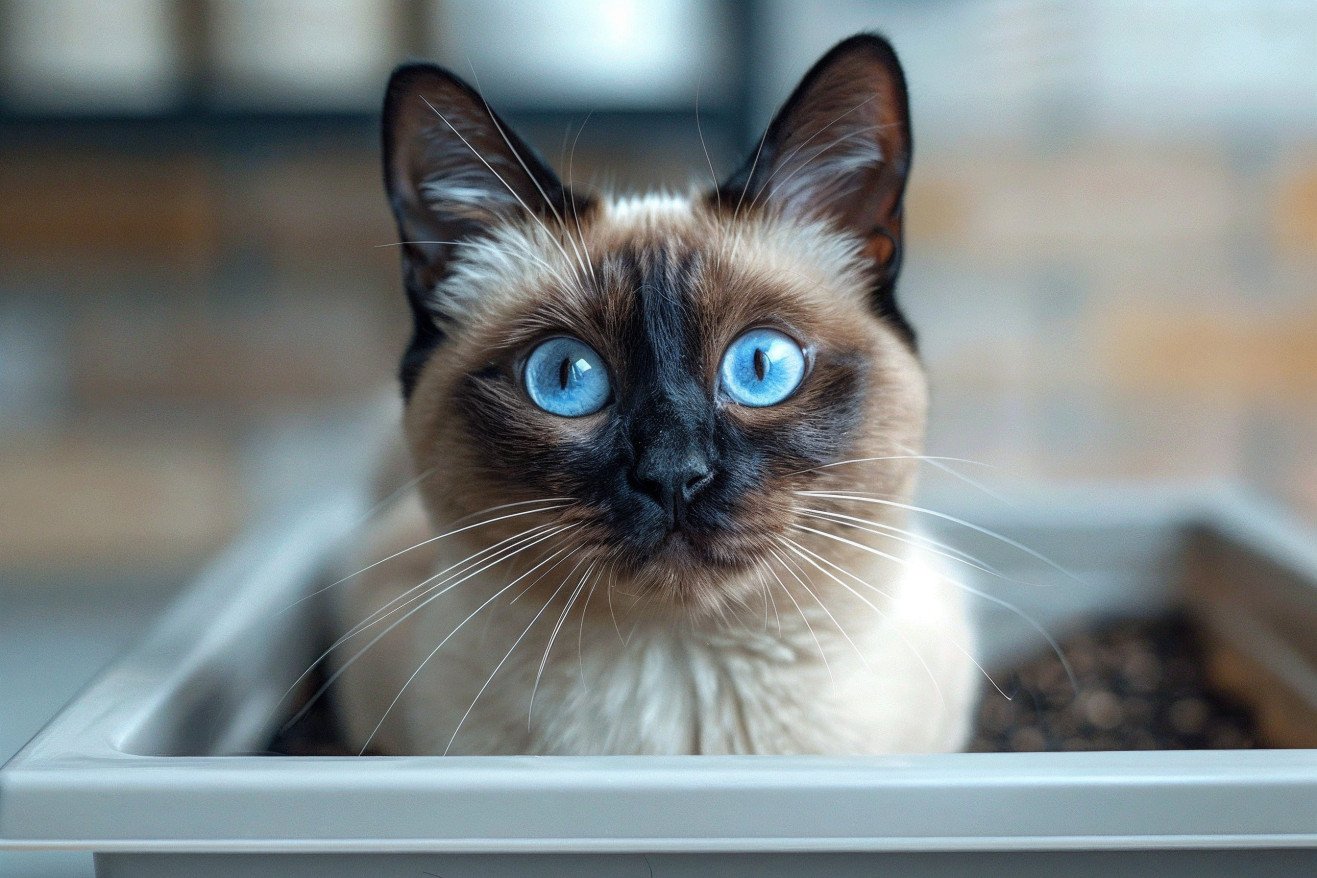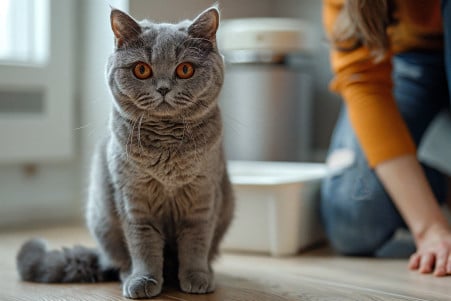Why Is My Cat Peeing Over the Litter Box and How Can I Stop It? Causes and Solutions
9 May 2024 • Updated 9 May 2024

Why is your cat peeing over the edge of the litter box? This is a common question that many cat owners ask when they're dealing with the mess and smell that comes with this frustrating problem. More importantly, what can you do to stop it? Cats can pee over the edge of the litter box for a number of reasons, including litter aversion, marking territory, health issues like urinary tract infections, and even the location and size of the box. However, there are ways to stop this behavior.
While it may be tempting to throw in the towel, there's no need to give up and let your cat have its way. In this article, we'll take a deep dive into the latest studies from veterinarians and animal behaviorists to find the best methods for identifying the causes of this problem and the most effective ways to solve it. By the end of this article, you'll have the knowledge you need to stop your cat from peeing over the edge of the litter box and get back to enjoying your furry friend's company without the mess.
Why is my cat peeing over the edge of the litter box?
Medical Causes of Litter Box Problems
There are a number of medical reasons that may cause a cat to be unable or unwilling to use the litter box. PetMD lists urinary tract infections, bladder stones, kidney disease, and diabetes as potential causes of frequent urination and incontinence. Arthritis or other physical issues may make it difficult for a cat to get in and out of the litter box comfortably.
Neurological disorders, cognitive dysfunction, or sensory deficits may impact a cat's ability to find or use the litter box. As noted by The Cat Vet, arthritis, tail injuries, or anemia may make it difficult for cats to maintain the correct toileting posture. It's important to make sure that any medical issues are treated by a veterinarian before you try to address litter box problems with environmental or behavioral changes.
Making the Litter Box More Cat-Friendly
The size, shape, and location of the litter box can all impact whether a cat uses it consistently. Spring Creek Animal Hospital notes that litter boxes should be large enough for the cat to move around in, with low sides for easy access. They also recommend uncovered litter boxes in a quiet area that’s away from the hustle and bustle of the home.
In addition to scooping the litter box at least once a day and cleaning it weekly, The Spruce Pets suggests trying different types of litter and substrates to see if one is more appealing to the cat.
By making the litter box more cat-friendly and keeping it clean, cat owners can help eliminate some of the issues that may be causing their cat to avoid the litter box. However, it’s also important to address territorial marking and stress-related problems to fully resolve litter box issues.
Dealing With Territorial Marking and Stress-Related Behaviors
Cats may exhibit vertical peeing or spraying as a form of territorial marking or due to stress and anxiety. Catster notes that territorial marking can be triggered by environmental changes, new family members (human or animal), or conflicts with other pets. Stress and anxiety can be caused by a variety of factors, including changes in schedule, lack of stimulation, and conflicts within the home.
Making sure that your cat has plenty of resources (litter boxes, scratching posts, hiding places) and minimizing stressors can help reduce marking. The ASPCA suggests reducing stress in the home and conflicts between cats to help with litter box issues. Pheromone diffusers, calming supplements, and environmental enrichment can also help reduce stress-related litter box avoidance, according to PetHelpful.
By recognizing the behavioral issues that can lead to litter box problems, cat parents can take a more holistic approach to getting their cats back on track with their litter box habits.
Litter Box Solutions for Multi-Cat Households
If you have more than one cat, you may find that litter box problems are more common because of territorial issues and resource guarding. The ASPCA suggests that the general rule is to have one litter box per cat plus one extra to make sure that there are enough boxes and no one has to compete for access.
Make sure that the litter boxes are in different, easily accessible locations that take into account each cat's territory and preferences. Spring Creek Animal Hospital suggests that you even put the boxes in different rooms. It can also be helpful to introduce new litter boxes slowly and use positive reinforcement to make sure that the cats are using them.
In addition, providing separate resources (like food, water, and scratching posts) and vertical space can help reduce conflict and stress between cats. By making sure that you're taking into account the specific needs of multi-cat households, you can help ensure that your cats are using their litter boxes and avoid unwanted urination.
Litter Box Training and Positive Reinforcement Techniques
Proper litter box training can help establish good habits and prevent litter box avoidance from an early age. According to Four Paws, gradually introducing kittens to the litter box and using positive reinforcement (treats, praise) when they use it correctly can reinforce the desired behavior.
For adult cats, retraining may be necessary if litter box issues arise due to environmental changes or negative associations. The SPCA of British Columbia emphasizes the importance of patience and consistency when implementing litter box training, as it may take time for the cat to adapt to the new routine. Avoiding punishment and focusing on positive reinforcement can help create a stress-free learning environment for the cat.
As recommended by Hill's Pet Nutrition, assembling the proper supplies, gradually introducing the litter box, and using positive reinforcement are key to successful litter box training. By addressing litter box issues through a comprehensive, compassionate approach, cat owners can restore harmony in the home.
Specialized Litter Box Solutions and Accessories
In addition to the general tips above, some cats may need specialized litter box solutions to help them overcome their litter box issues. Floppycats notes that high-sided litter boxes with walls that are at least 6 inches tall can help contain urine for cats that pee vertically or spray. Meanwhile, top-entry litter boxes and litter boxes with ramps can help cats with mobility issues or arthritis.
In addition, litter box mats or trays can help contain litter scatter and make cleaning up after your cat easier. The Spruce Pets also notes that automatic self-cleaning litter boxes and air purifiers can help ensure that your home stays clean and odor-free for cats that are especially sensitive to their environment. By using these and other specialized solutions and accessories, cat owners can help their cats overcome their litter box issues and live in peace and harmony.
Conclusion: How to Get Your Cat to Use the Litter Box Again
Dealing with litter box avoidance is a complex issue that requires a multi-faceted approach that takes into account medical, environmental, and behavioral concerns. Regular vet visits, ensuring the right litter box conditions, and managing stress are all important in dealing with and avoiding litter box problems. When it comes to training and behavior modification, it’s important to be patient, consistent, and use positive reinforcement.
By understanding the causes of the problem and finding the right solutions, cat owners can get their cats to use the litter box again and have a clean, fresh-smelling home. With the right techniques and dedication, litter box issues can be managed, leading to a happier, healthier relationship with your cat.


